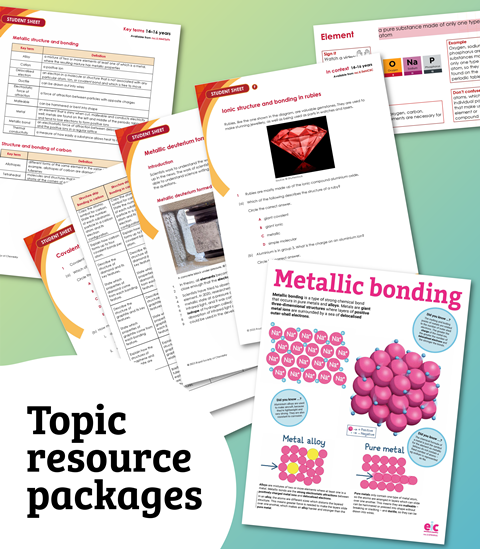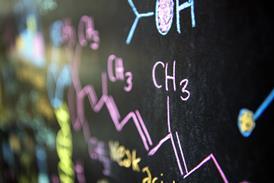All Johnstone's model articles
-
 Resource
ResourceDiffusion and chemical reactions | Developing understanding | 11–14
Encourage learners to deepen their understanding of diffusion and chemical reactions and how these processes are represented at different conceptual levels of thinking
-
 Resource
ResourceDiffusion and dissolving | Developing understanding | 11–14
Encourage learners to deepen their understanding of diffusion and dissolving and how these processes are represented at different conceptual levels of thinking
-
 Resource
ResourceDiffusion of colour in water | Johnstone’s triangle worksheets | 11–14 years
Use this worksheet to develop learners’ understanding of diffusion as they observe coloured dyes diffusing in water
-
 Resource
ResourceMelting and boiling | Johnstone’s triangle worksheets | 11–14 years
Develop learners’ understanding of melting and boiling with this worksheet, including a teacher demonstration for learners to observe
-
 Resource
ResourceMelting and boiling points | Developing understanding | 11–14
Deepen understanding of melting and boiling points and how these are represented at different conceptual levels of thinking
-
 Resource
ResourceDissolving salt | Johnstone’s triangle worksheets | 11–14 years
Use this worksheet to develop learners’ understanding of solutions as they observe how salt and sand behave in water
-
 Resource
ResourceSolutions | Developing understanding | 11–14
Encourage learners to deepen their understanding of solutions and how they are represented at different conceptual levels of thinking
-
 Resource
ResourceStates of matter | Developing understanding | 11–14 years
Encourage learners to deepen their understanding of states of matter and how they are represented at different conceptual levels of thinking
-
 Resource
ResourceStates of matter | Johnstone’s triangle worksheets | 11–14 years
Use this worksheet to develop learners’ understanding of states of matter, including a teacher demonstration
-
 Resource
ResourceIsotopes of hydrogen | Johnstone’s triangle | 14–16 years
Use this worksheet to develop learners’ understanding of atoms and isotopes by considering ‘heavy water’ ice cubes
-
 Resource
ResourceAtoms and isotopes | Developing understanding | 14–16
Encourage learners to deepen their understanding of isotopes from the macroscopic to sub-microscopic level
-
 Resource
ResourceAtoms and ions | Developing understanding | 14–16 years
Encourage learners to think about how atoms and ions are represented and what this means at the sub-microscopic level
-
 Resource
ResourceAtoms and ions of copper | Johnstone’s triangle worksheets | 14–16 years
Use these worksheets to develop learners’ understanding of atoms and ions, including a demonstration of a metal displacement reaction
-
 Resource
ResourceAtomic structure of lithium | Johnstone’s triangle worksheets | 14–16 years
Use these worksheets to develop learners’ understanding of atomic structure, using the example of lithium
-
 Resource
ResourceAtomic structure | Developing understanding | 14–16 years
Encourage learners to think about how the atomic structure is represented and what this means at the sub-microscopic level
-
 Resource
ResourceParticle diagrams of water | Johnstone’s triangle worksheets | 14–16 years
Use these worksheets to develop learners’ understanding of particle diagrams of water in the solid, liquid and gas state
-
 CPD article
CPD articleTeaching conservation of mass at 14–16
Help learners master the concept of conservation of mass with these hands-on teaching ideas
-
 Resource
ResourceCovalent bonding | Developing understanding | 14–16 years
Develop learners’ understanding of the size and shape of covalent structures by interpreting a range of diagrams and models
-
 Resource
ResourceIonic bonding | Developing understanding | 14–16 years
Develop learners’ understanding of ionic lattices through comparing 2D and 3D representations
-
 Resource
ResourceMetallic bonding | Developing understanding | 14–16
Develop learners’ sub-microscopic understanding by interpreting a range of models used to represent metallic structure and metal ions











